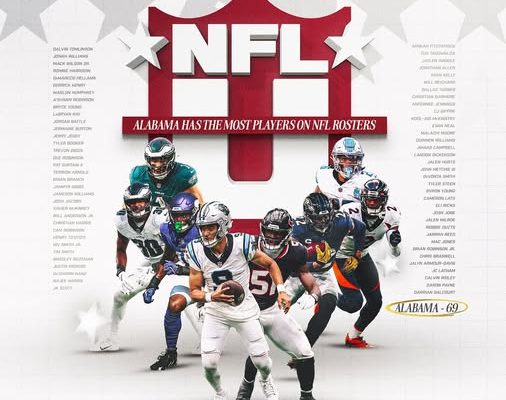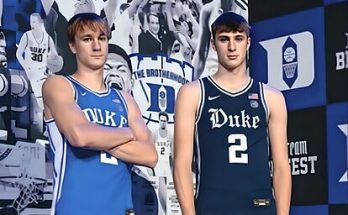Alabama football has built a reputation that goes far beyond the confines of Bryant-Denny Stadium and the SEC. For nine consecutive seasons, the Crimson Tide have led the nation in the number of players on NFL rosters, a testament to the program’s consistency, player development, and recruiting prowess. This streak, unmatched by any other college football program, underscores not only the dominance Alabama has had on Saturdays but also its ability to prepare athletes for the next level. To fully appreciate the significance of this achievement, one must look at the broader context of college football, the NFL pipeline, and what it means for both the players and the program.
The foundation of Alabama’s NFL dominance lies in recruiting. Nick Saban, who took over the program in 2007, created a culture where the best high school players in the country wanted to be part of his system. The Tide consistently land top-five recruiting classes, and many of those players develop into NFL-caliber talent. But signing stars out of high school is only one part of the equation. What has truly separated Alabama from others is the way the program molds those recruits into professionals. From strength and conditioning to mastering complex schemes, Alabama athletes leave Tuscaloosa with a blueprint for what NFL organizations demand. This is why NFL general managers and scouts flock to Alabama’s pro days and pay close attention to their players year after year.
When comparing Alabama to other powerhouse programs, the difference becomes clearer. Schools like Georgia, Ohio State, LSU, and Clemson have each had surges in producing NFL talent, but Alabama’s consistency is what sets them apart. Leading the nation for nine straight seasons isn’t a coincidence; it’s the result of a system that’s been refined and sustained for nearly two decades. During this stretch, Alabama has not only put dozens of players into the league but has also produced stars, Pro Bowlers, and even NFL All-Pros. From Julio Jones to Derrick Henry, Minkah Fitzpatrick to Patrick Surtain II, Alabama players haven’t just filled NFL rosters—they’ve shaped them.
One fascinating aspect of Alabama’s NFL pipeline is the balance across positions. While some schools may be known for producing elite players at a single position—say, LSU with wide receivers or Wisconsin with offensive linemen—Alabama has been a factory for talent across the board. Quarterbacks like Tua Tagovailoa, Jalen Hurts, and Mac Jones have carved out careers in the league. Running backs from Mark Ingram to Josh Jacobs have been productive. The Tide’s tradition of dominant wideouts has continued with names like DeVonta Smith, Jaylen Waddle, Jerry Jeudy, and Calvin Ridley. On defense, Alabama has pumped out linebackers like C.J. Mosley and Rashaan Evans, defensive linemen such as Quinnen Williams and Jonathan Allen, and defensive backs like Marlon Humphrey and Trevon Diggs. The spread of talent across the roster shows that Alabama doesn’t specialize in one area—they develop entire football teams capable of thriving on Sundays.
The streak of leading the nation in NFL roster representation also speaks to the trust that pro organizations have in Alabama’s development model. In the NFL, drafting is as much about risk management as it is about talent evaluation. Teams want to invest in players who have been battle-tested, disciplined, and exposed to high-level schemes. Alabama players often arrive in the league more “pro ready” than their peers. Coaches like Saban run practices and programs that mirror the NFL in structure and intensity, which shortens the learning curve once a player makes the jump. This gives Alabama prospects a unique advantage during draft evaluations. When an NFL front office sees the Alabama logo next to a player’s name, there is a baseline confidence in what they’re getting.
Another factor in Alabama’s NFL dominance is durability and adaptability. Not every five-star recruit becomes a first-round draft pick, but many still carve out careers as role players or depth pieces on NFL teams. This depth of production is another reason why Alabama leads the nation in roster representation. Even players who weren’t considered stars at Alabama often find ways to contribute in the NFL because of the preparation they received. Being part of a program where competition is fierce at every position forces players to adapt, refine their skills, and stay mentally tough. That resilience translates to the NFL, where roster spots are highly competitive and careers are often short.
This streak also has a powerful impact on recruiting. High school athletes pay attention to which programs put the most players into the league, and Alabama’s dominance in this category is a major selling point. Every teenager dreaming of NFL stardom sees Alabama as the most reliable launchpad to achieve it. When coaches sit in living rooms with recruits and their families, they can point to tangible proof of success: nine straight years of leading the country in NFL players. That type of track record speaks louder than any recruiting pitch, and it keeps Alabama’s pipeline flowing strong.
Of course, this success also reinforces Alabama’s standing within the college football world. Dominating in NFL representation validates their dominance on the field. The two go hand in hand. Winning national championships, producing NFL draft picks, and filling pro rosters all come from the same culture of excellence. It creates a feedback loop where success breeds more success. Top players want to join, competition in practice raises everyone’s level, NFL scouts take notice, and the program’s reputation grows even stronger. It’s not just about winning games on Saturdays—it’s about building careers that extend far beyond.
Some critics argue that Alabama’s system is almost too professional, that it turns college football into an NFL factory rather than focusing on the student-athlete experience. But from the perspective of players who dream of playing professionally, Alabama offers an unmatched environment. They get to compete at the highest level of college football while being trained to meet the standards of the NFL. For many, this is exactly what they want when they commit to Alabama. The program isn’t for everyone—it requires sacrifice, discipline, and the ability to handle constant competition—but for those who embrace it, the rewards are clear.
The nine-year streak also brings attention to Nick Saban’s legacy. While Alabama may eventually pass the torch to a new head coach, Saban’s fingerprints are all over this achievement. His meticulous attention to detail, relentless demand for excellence, and ability to adapt to changes in the game have kept Alabama at the forefront. Even in an era where other programs are closing the gap, Alabama continues to churn out NFL talent at an unmatched rate. This speaks volumes about the culture Saban built and the infrastructure that supports player development in Tuscaloosa.
It’s also worth noting that sustaining this streak is not easy in today’s college football landscape. With the transfer portal reshaping rosters and NIL opportunities influencing player decisions, the ability to recruit and develop NFL talent could easily shift. Yet Alabama has adapted to these changes while maintaining their status as the nation’s top NFL producer. Players still see the long-term value of playing for Alabama, even as the sport evolves around them. The chance to be part of a program that consistently delivers NFL careers outweighs many short-term incentives.



